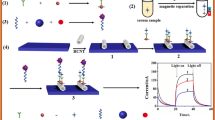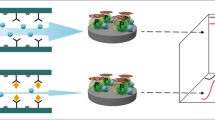Abstract
This study aimed to develop a quenching-type electrochemiluminescence (ECL) immunosensor for human epidermal growth factor receptor (Her-2) detection. Firstly, Pd/NiFeOx nanoflowers decorated by in situ formation of gold nanoparticles (Au NPs) and 2D Ti3C2 MXene nanosheets were synthesized (AuPd/NiFeOx/Ti3C2) as carriers to load luminol and primary antibodies. Impressively, AuPd/NiFeOx/Ti3C2 with excellent peroxidase-like activity could accelerate the decomposition of the coreactant H2O2 generating more reactive oxygen species (ROSs) under the working potential from 0 to 0.8 V, resulting in highly efficient ECL emission at 435-nm wavelengths. The introduction of tungsten-based polyoxometalate nanoclusters (W-POM NCs) which exhibit remarkable ROSs-scavenging activity as secondary antibody labels could improve the sensitivity of immunosensors. The ZnO nanoflowers were employed to encapsulate minute-sized W-POM NCs, and polydopamine was self-polymerized on the surface of Zn(W-POM)O to anchor secondary antibodies. The mechanism of the quenching strategy was explored and it was found that W-POM NCs could consume ROSs by the redox reaction of W5+ resulting in W6+. The proposed ECL immunosensor displayed a wide linear response range of 0.1 pg·mL−1 to 50 ng·mL−1, and a low detection limit of 0.036 pg mL−1 (S/N = 3). The recoveries ranged from 93.9 to 99.4%, and the relative standard deviation (RSD) was lower than 10%. This finding is promising for the design of detecting new protein biomarkers.
Graphical abstract






Similar content being viewed by others
Data availability
All data generated or analysed during this study are included in this published article and its supplementary information files.
References
Li X, Du Y, Wang H, Ma H, Wu D, Ren X, Wei Q, Xu J-J (2020) Self-supply of H2O2 and O2 by hydrolyzing CaO2 to enhance the electrochemiluminescence of luminol based on a closed bipolar electrode. Anal Chem 92(18):12693–12699. https://doi.org/10.1021/acs.analchem.0c03170
Li X, Sun X, Fan D, Yan T, Feng R, Wang H, Wu D, Wei Q (2019) A ternary quenching electrochemiluminescence insulin immunosensor based on Mn2+ released from MnO2@Carbon core-shell nanospheres with ascorbic acid quenching AuPdPt-MoS2@TiO2 enhanced luminol. Biosens Bioelectron 142:111551–111557. https://doi.org/10.1016/j.bios.2019.111551
Zhang H-R, Wu M-S, Xu J-J, Chen H-Y (2014) Signal-on dual-potential electrochemiluminescence based on luminol–gold bifunctional nanoparticles for telomerase detection. Anal Chem 86(8):3834–3840. https://doi.org/10.1021/ac403960g
Jiang X, Wang Z, Wang H, Zhuo Y, Yuan R, Chai Y (2017) A novel metal–organic framework loaded with abundant N-(aminobutyl)-N-(ethylisoluminol) as a high-efficiency electrochemiluminescence indicator for sensitive detection of mucin1 on cancer cells. Chem Commun 53:9705–9708. https://doi.org/10.1039/c7cc05495e
Sun J, Sun H, Liang Z (2017) Nanomaterials in electrochemiluminescence sensors. ChemElectroChem 4(7):1651–1662. https://doi.org/10.1002/celc.201600920
Farka Z, Jurik T, Kovar D, Trnkova L, Skladal P (2017) Nanoparticle-based immunochemical biosensors and assays: recent advances and challenges. Chem Rev 117(15):9973–10042. https://doi.org/10.1021/acs.chemrev.7b00037
Huang W, Wang Y, Liang W-B, Hu G-B, Yao L-Y, Yang Y, Zhou K, Yuan R, Xiao D-R (2021) Two birds with one stone: surface functionalization and delamination of multilayered Ti3C2Tx MXene by grafting a ruthenium(II) complex to achieve conductivity-enhanced electrochemiluminescence. Anal Chem 93(3):1834–1841. https://doi.org/10.1021/acs.analchem.0c04782
Yao B, Zhang J, Fan Z, Ding Y, Zhou B, Yang R, Zhao J, Zhang K (2021) Rational engineering of the DNA walker amplification strategy by using a Au@Ti3C2@PEI-Ru(dcbpy)32+ nanocomposite biosensor for detection of the SARS-CoV-2 RdRp Gene. ACS Appl Mater Interfaces 13(17):19816–19824. https://doi.org/10.1021/acsami.1c04453
Zeng R, Wang W, Chen M, Wan Q, Wang C, Knopp D, Tang D (2021) CRISPR-Cas12a-driven MXene-PEDOT:PSS piezoresistive wireless biosensor. Nano Energy 82:105711–105720. https://doi.org/10.1016/j.nanoen.2020.105711
Naveen MH, Gurudatt NG, Noh H-B, Shim Y-B (2016) Dealloyed AuNi dendrite anchored on a functionalized conducting polymer for improved catalytic oxygen reduction and hydrogen peroxide sensing in living cells. Adv Func Mater 26(10):1590–1601. https://doi.org/10.1002/adfm.201504506
Xl A, Fm A, My A, Jzb C (2022) Nanomaterial based analytical methods for breast cancer biomarker detection. Mater Today Adv 14:100219–100236. https://doi.org/10.1016/j.mtadv.2022.100219
Salahandish R, Ghaffarinejad A, Naghib SM, Majidzadeh AK, Zargartalebi H, Sanati-Nezhad A (2018) Nano-biosensor for highly sensitive detection of HER2 positive breast cancer. Biosens Bioelectron 117:104–111. https://doi.org/10.1016/j.bios.2018.05.043
Zeng R, Li Y, Li Y, Wan Q, Huang Z, Qiu Z, Tang D (2022) Smartphone-based photoelectrochemical immunoassay with Co9S8@ZnIn2S4 for point-of-care diagnosis of breast cancer biomarker. Research 2022:9831521–9831529. https://doi.org/10.34133/2022/9831521
Lv S, Zhang K, Zeng Y, Tang D (2018) Double photosystems-based ‘Z-Scheme’ photoelectrochemical sensing mode for ultrasensitive detection of disease biomarker accompanying three-dimensional DNA walker. Anal Chem 90(11):7086–7093. https://doi.org/10.1021/acs.analchem.8b01825
Li X, Ma F, Yang M, Zhang J (2022) Nanomaterial based analytical methods for breast cancer biomarker detection, Mater Today Adv 14:100219–100235. https://doi.org/10.1016/j.mtadv.2022.100219
Dervisevic M, Alba M, Adams TE, Prieto-Simon B, Voelcker NH (2021) Electrochemical immunosensor for breast cancer biomarker detection using high-density silicon microneedle array. Biosens Bioelectron 192:113496. https://doi.org/10.1016/j.bios.2021.113496
Proust A, Thouvenot R, Gouzerh P (2008) Functionalization of polyoxometalates: towards advanced applications in catalysis and materials science. Chem Commun 16:1837–1852. https://doi.org/10.1039/B715502F
Song Y-F, Tsunashima R (2012) Recent advances on polyoxometalate-based molecular and composite materials. Chem Soc Rev 41(22):7384–7402. https://doi.org/10.1039/C2CS35143A
Bijelic A, Aureliano M, Rompel A (2018) The antibacterial activity of polyoxometalates: structures, antibiotic effects and future perspectives. Chem Commun 54(10):1153–1169. https://doi.org/10.1039/C7CC07549A
Bijelic A, Rompel A (2017) Ten good reasons for the use of the tellurium-centered anderson–evans polyoxotungstate in protein crystallography. Acc Chem Rese 50(6):1441–1448. https://doi.org/10.1021/acs.accounts.7b00109
Du Y, Yu S, Ju H (2022) Quenching of tungsten-based polyoxometalate nanoclusters on electrochemiluminescence emission of luminol loaded CeVO4/Au for immunoassay of protein. Anal Chim Acta 1210:339883–339889. https://doi.org/10.1016/j.aca.2022.339883
Zhang W, Jiang X, Dong Z, Wang J, Zhang N, Liu J, Xu G R, Wang L (2021) Porous Pd/NiFeOx nanosheets enhance the pH‐universal overall water splitting. Adv Funct Mater 31(51):2107187–2107192. https://doi.org/10.1002/adfm.202107181
Zhou J, Zhao W, Miao Z, Wang J, Ma Y, Wu H, Sun T, Qian H, Zha Z (2020) Folin-Ciocalteu assay inspired polyoxometalate nanoclusters as a renal clearable agent for non-inflammatory photothermal cancer therapy. ACS Nano 14(2):2126–2136. https://doi.org/10.1021/acsnano.9b08894
Cao M, Wang F, Zhu J, Zhang X, Qin Y, Wang L (2017) Shape-controlled synthesis of flower-like ZnO microstructures and their enhanced photocatalytic properties. Mater Lett 192:1–4. https://doi.org/10.1016/j.matlet.2017.01.051
Qiu Z, Tang D, Shu J, Chen G, Tang D (2016) Enzyme-triggered formation of enzyme-tyramine concatamers on nanogold-functionalized dendrimer for impedimetric detection of Hg(II) with sensitivity enhancement. Biosens Bioelectron 75:108–115. https://doi.org/10.1016/j.bios.2015.08.026
Xu M, Gao Z, Wei Q, Chen G, Tang D (2015) Hemin/G-quadruplex-based DNAzyme concatamers for in situ amplified impedimetric sensing of copper(II) ion coupling with DNAzyme-catalyzed precipitation strategy. Biosens Bioelectron 74:1–7. https://doi.org/10.1016/j.bios.2015.05.056
Zhang X, Du Y, Liu X, Feng R, Jia Y, Ren X, Zhang N, Liu L, Wei Q, Ju H (2023) Enhanced anode electrochemiluminescence in split aptamer sensor for kanamycin trace monitoring. Food Chem 420:136083–136090. https://doi.org/10.1016/j.foodchem.2023.136083
Yu Z, Gong H, Li Y, Xu J, Zhang J, Zeng Y, Liu X, Tang D (2021) Chemiluminescence-derived self-powered photoelectrochemical immunoassay for detecting a low-abundance disease-related protein. Anal Chem 93(39):13389–13397. https://doi.org/10.1021/acs.analchem.1c03344
Shu J, Qiu Z, Zhou Q, Lin Y, Lu M, Tang D (2016) Enzymatic oxydate-triggered self-illuminated photoelectrochemical sensing platform for portable immunoassay using digital multimeter. Anal Chem 88(5):2958–2966. https://doi.org/10.1021/acs.analchem.6b00262
Jia Y, Ren X, Zhang X, Wu D, Ma H, Li Y, Wei Q (2023) Encapsulation of tetraphenylethylene derivative in liposome vesicles as promising aggregation-induced electrochemiluminescence emitter for detection of human epidermal growth factor receptor 2. Anal Chem 95(24):9139–9144. https://doi.org/10.1021/acs.analchem.3c01957
Funding
This work was financially supported by the National Natural Science Foundation of China (no. 21427808).
Author information
Authors and Affiliations
Corresponding authors
Ethics declarations
Conflict of interest
The authors declare no competing interests.
Additional information
Publisher's Note
Springer Nature remains neutral with regard to jurisdictional claims in published maps and institutional affiliations.
Supplementary Information
Below is the link to the electronic supplementary material.
Rights and permissions
Springer Nature or its licensor (e.g. a society or other partner) holds exclusive rights to this article under a publishing agreement with the author(s) or other rightsholder(s); author self-archiving of the accepted manuscript version of this article is solely governed by the terms of such publishing agreement and applicable law.
About this article
Cite this article
Lu, Y., Li, X., Shi, S. et al. Tungsten-based polyoxometalate nanoclusters with remarkable reactive oxygen species-scavenging activity efficiently quenched luminol-based electrochemiluminescence for sensitive detection of Her-2. Microchim Acta 191, 21 (2024). https://doi.org/10.1007/s00604-023-06100-7
Received:
Accepted:
Published:
DOI: https://doi.org/10.1007/s00604-023-06100-7




